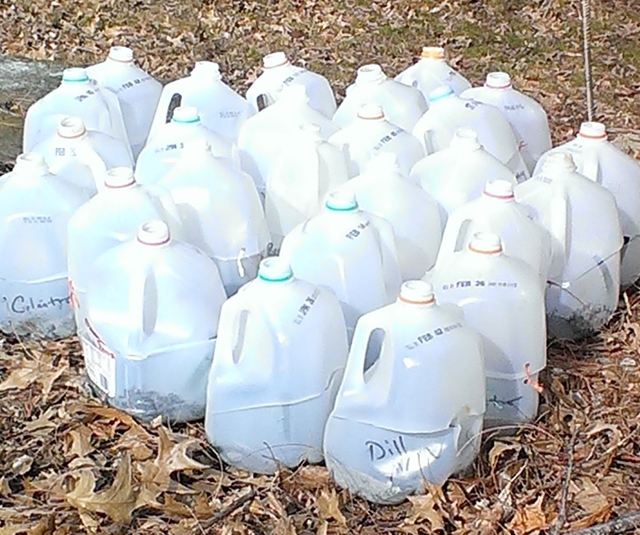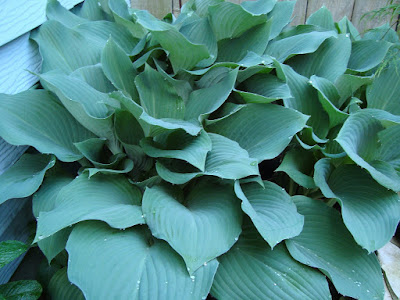The Sun's Effect on Blue Hostas
Blue hostas require the most protection from the sun because the blue color is actually a waxy coating on the top and or bottom side of the leaves. The leaves are actually a shade of green, but the waxy coating makes them appear those great shades of blue.
Too much sun can cause the waxy coating on blue hosta leaves to melt off and expose the green leaf underneath. This is the reason it is recommended that blue hostas are planted in more shade than other hostas.
The blue hostas are always very popular and there are several shades of blue-leaved hostas. Blue hosta leaves will become bluer and bluer each year as they move to maturity, usually about four to five years.
What's the best siting for a blue hosta?
The best siting for hostas with blue foliage is some morning sun and afternoon shade. If your blue hosta is keeping its blue color through most or all of the season, it's obviously in the right spot.
Keep in mind, though, that blue hosta cultivars differ greatly in their blue coloring and in how long they will hold their blue color into the season.
Things to Consider
Hard or prolonged rain can wash off the waxy coating and give the hosta the appearance of green spots like you can see in the above picture. It is normal to see color changes in the hosta leaves throughout the growing season as the sun grows more intense. These changes are temporary for the season.
Hostas with thicker substance to their leaves can take more sun as they can absorb and hold more moisture. Big Daddy is a great example of this. Conversely, hostas with thinner leaves are more susceptible to sun-scald.
The leaf shape of a blue hosta will cast a different shade of blue on the leaves. For instance, leaves that are twisted or corrugated or that have deep veins will cast a deeper blue than hostas with smoother leaves.
There are hostas that are “Sun Tolerant.” If your hosta is advertised as such, it is your best bet for placement in some sun. When it comes to blue hostas, though, the blue leaves will turn green during the season when placed in some direct sun.
~~~~~~~~~~~~~~~~~~~~~~~~~~~~~~~~~~~~~~~~~~~~~~~
Blue hostas grown in warmer locations may only keep their blue hue until late June, while in the northern climates, the leaves will remain blue longer.
~~~~~~~~~~~~~~~~~~~~~~~~~~~~~~~~~~~~~~~~~~~~~~~
Hostas are such a forgiving perennial, they can easily be moved to a more suitable location until it's in just the right spot. If the leaves do turn green for a season, not to worry. The blue waxy coating will return as the hosta emerges the next season.
The blue colors of hostas have been described in many ways, including deep blue, powdery blue, intense blue, icy blue, silvery blue, and chalky blue. But no matter which term you use, with the right care and placement, blue hostas will add a peaceful, cooling feeling to your perennial shade garden.
Because there are so many variables to consider, you could follow all of the above suggestions and still not be successful in achieving an exact leaf color.
One of the great things about hostas is that they're easy to dig up and move to another location. And there's always the possibility of planting your hosta in a pot. Then you can move it around until it's in just the right spot for the coloring you're after.
Hostas continue to be a favorite perennial plant for plenty of reasons. Their toughness, beauty, ease of care, and variety of great leaf colors and shapes make them one of the best plants for a shade or semi-shade garden.
~~~~~~~~~~

Have You Tried Winter Sowing??
If you haven't tried winter sowing, you're in for a treat. This method is especially good for sowing herbs. Winter sowing is basically sowing seeds in the bottom of milk jugs in the winter, setting the milk jugs outside for the winter and leaving them there until the seeds germinate in the Spring.
For our article containing detailed information about Winter Sowing, click here.
To watch our 30 minute video on how to winter sow, click here.
Other Related Articles
Winter Sowing. What to do after Sprouting
Winter Sowing - Common Failures and How to Avoid Them
This post may contain Amazon affiliate links and as an Amazon Associate I earn from qualifying purchases without costing you anything.
This post may contain Amazon affiliate links and as an Amazon Associate I earn from qualifying purchases without costing you anything.






.png)






No comments:
Post a Comment
Note: Only a member of this blog may post a comment.